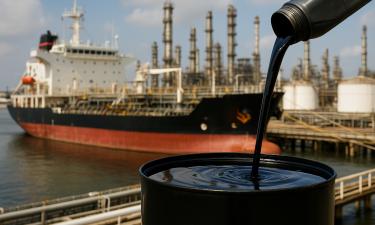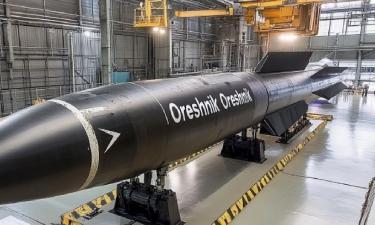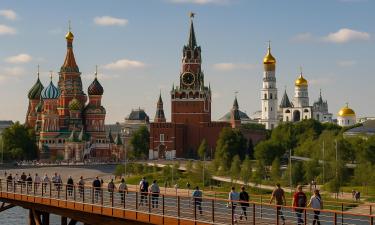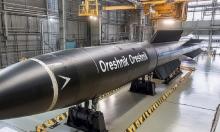A Kerch Strait Gibraltar
 Russian Foreign Minister Igor Ivanov is set to arrive in Kiev for talks with his Ukrainian counterpart Konstantin Grishchenko. The ministers are expected to discuss a number of difficult problems, including the Tuzla issue. The island of Tuzla, which is seven km long and 500 metres wide, is located in the central section of the Kerch Strait, and has strained Russian-Ukrainian relations in the last 30 days, or so. There are reasons for this, but, at the same time, the Tuzla problem simply did not exist until 1991. What, then, are the causes of the current tension?
Russian Foreign Minister Igor Ivanov is set to arrive in Kiev for talks with his Ukrainian counterpart Konstantin Grishchenko. The ministers are expected to discuss a number of difficult problems, including the Tuzla issue. The island of Tuzla, which is seven km long and 500 metres wide, is located in the central section of the Kerch Strait, and has strained Russian-Ukrainian relations in the last 30 days, or so. There are reasons for this, but, at the same time, the Tuzla problem simply did not exist until 1991. What, then, are the causes of the current tension?
When the Soviet Union disintegrated in late 1991 and Russia and Ukraine became sovereign states, the border demarcation issue arose. Due to its location, Tuzla became a key aspect in this process, also influencing both countries' efforts to determine the existing and projected statuses of the Kerch Strait, as well as the Sea of Azov. All one has to do is take a look at the map, and everything becomes clear: Tuzla is a veritable rock of Gibraltar dividing the Black Sea and the Sea of Azov. The Kerch Strait passes along its tip.
The conflict flared up on September 29, when Russian workers started building a four-kilometre dam between the Taman Peninsula, which belongs to Russia, and the island of Tuzla. This construction project is designed to ease Taman's environmental problems. In the past, Tuzla was part of a natural spit that shielded the peninsula from salt waters of the Black Sea. However, erosion led to the spit disappearing in the mid-1920s, to the point when Tuzla became an island. The Black Sea then started chiselling away at the Taman shoreline. Experts say that the local shoreline is receding at a rate of three metres per year; the permanent flood threat should not be overlooked either.
Taman fishermen have also suffered because schools of fish, which used to gather in Taman Bay, started leaving the area along a newly formed channel. Valuable fish species, for example sturgeon and pike perch, used to enter the freshwater bay from the Kuban river, but when Taman Bay became connected to the Black Sea the salt water could no longer provide the freshwater fish with their natural habitat.
Kiev, which sees Tuzla as Ukrainian territory, decided that the Russian dam-construction project was encroaching on Ukraine's territorial integrity. As a result, Ukrainian border guards were deployed on Tuzla post haste. Moreover, Kiev launched yet another phase of "preventive exercises" in the vicinity of the Kerch Strait, during which there were even plans to launch missiles. Ukrainian President Leonid Kuchma, who cut short an official visit to Latin America over the controversy, said he would assume responsibility for opening fire on the Russians as a last resort. On October 23 the Supreme Rada (Ukrainian Parliament) decided to request UN and NATO assistance, if Russia went ahead with the dam's construction.
In a bid to prevent the border conflict from escalating, Russian Prime Minister Mikhail Kasyanov and his Ukrainian counterpart Viktor Yanukovich met in Moscow on October 24, and agreed that Moscow would stop building the dam on the Russian-Ukrainian border. In return, Kiev agreed to withdraw its border guards from Tuzla, (though it has failed to do so) and negotiate the status of the entire Azov-Kerch water body in line with Moscow's long-standing demands.
The crux of the matter is that Ukraine wants to own approximately 66 percent of the entire Azov-Sea waters, while it would also like to acquire priority fishing rights and those for developing underwater sea-shelf resources. Approximately 120 shallow oil and gas seams have been discovered in the Sea of Azov that can be developed on a commercial basis. Prospectors have also discovered seven oil and gas deposits. The sea's Russian sector contains 50 million tonnes of oil and some 150-200 billion cubic metres of gas.
The Kerch Strait is the root of the problem. Kiev claims that the channel is located inside Ukrainian territorial waters. Therefore, it unequivocally believes that all foreign ships, including Russian ones, should pay canal-and-pilot fees. The Strait annually handles 8,000-8,500 ships, with Russian ships or those bound for Russian ports accounting for 65 percent of the total. Russia loses some $15-16 million as a result of such Ukrainian actions. However, norms of international law expressly state that both Ukraine and Russia shall have equal rights to use the Kerch Strait, if the Azov Sea's inland-sea status is confirmed.
Acting in line with established international legal practice, Russia is proposing that the Sea of Azov and the Kerch Strait be delimited along the local seabed, leaving both countries free to use the water surface as they see fit. Ukraine, which insists that the water surface should be divided, would prefer to maintain the status quo.
Russian experts believe that one possible solution could be establishing a solely economic status for the Azov-Sea border under the jurisdiction of littoral countries, i.e. Russia and Ukraine. In that case, it would become possible to work out economic, fishing and other regulations pertaining to foreign ship navigation in the Sea of Azov and coast guard activity by Russian and Ukrainian border guards along the Black Sea border (in the direction of Turkey) on the basis of bilateral agreements.
The Tuzla situation is complicated. Therefore, any breakthroughs and sensations from the Russian minister's Kiev visit can hardly be expected. Most importantly, Moscow and Kiev should, in principle, agree to determine the status of the Azov Sea and the Kerch Strait, also delimiting local borders. This objective has to be accomplished even in the course of lengthy and difficult talks, thus preventing the island of Tuzla from becoming a veritable Gibraltar in Russian-Ukrainian relations.
Boris Petrov, RIAN
Subscribe to Pravda.Ru Telegram channel, Facebook, RSS!





